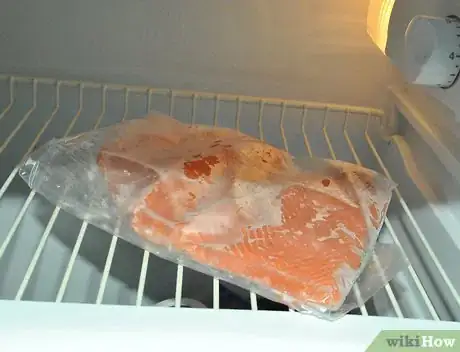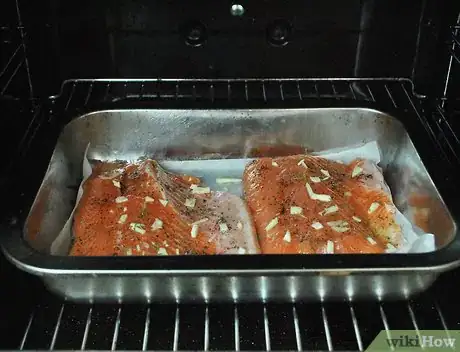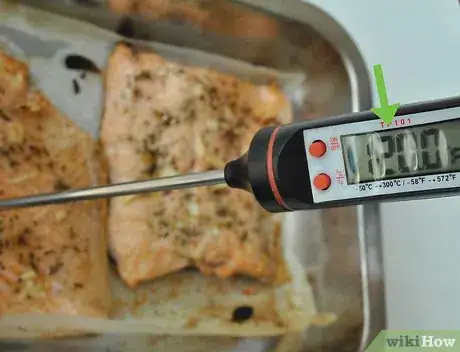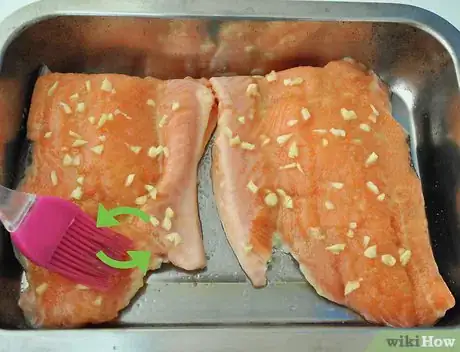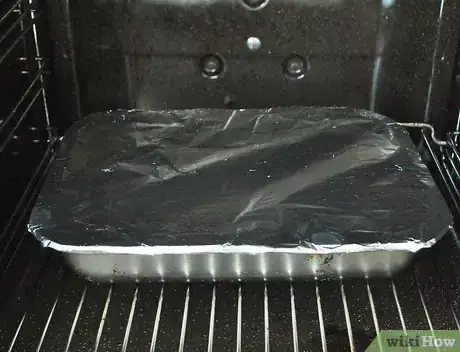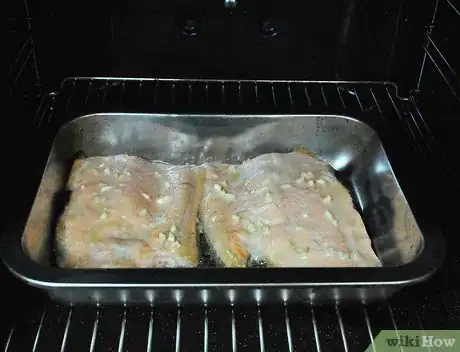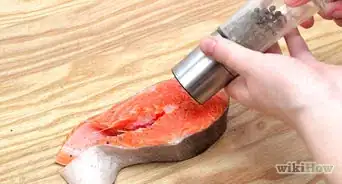This article was co-authored by wikiHow Staff. Our trained team of editors and researchers validate articles for accuracy and comprehensiveness. wikiHow's Content Management Team carefully monitors the work from our editorial staff to ensure that each article is backed by trusted research and meets our high quality standards.
There are 7 references cited in this article, which can be found at the bottom of the page.
This article has been viewed 23,222 times.
Learn more...
Frozen fish is typically chilled immediately after it’s caught, so it's actually fresher than non-frozen options.[1] For best quality, slowly thaw frozen salmon and other fatty fish varieties in the refrigerator before cooking. If you’re in a rush, give your fish a 5 minute hot water bath. If you really don’t feel like taking extra steps to thaw your salmon, cover it with foil for half of the total baking time. The foil will trap steam and help improve its texture.
Ingredients
Basic Baked Salmon Fillets
- 2 salmon fillets, about 6 ounces (170 g) each
- 2 to 3 tablespoons olive oil
- Salt
- Pepper
- Lemon wedges (for serving)
Makes 2 servings
Lemon, Garlic, and Dill Sauce[2]
- 1/2 stick of butter, melted
- Juice of 2 lemons
- 2 garlic cloves, minced
- 1 tablespoon dried dill
Dresses 2 salmon fillets (6 ounces (170 g) each)
Maple and Dijon Mustard Sauce[3]
- 2 teaspoons maple syrup
- 3 tablespoons Dijon mustard
- 2 garlic cloves, minced
- 1/2 teaspoon red pepper flakes (optional)
Dresses 2 salmon fillets (6 ounces (170 g) each)
Steps
Baking Thawed Salmon
-
1Thaw salmon in the refrigerator overnight for best results. It’s perfectly safe to cook salmon straight from the freezer without thawing it. However, fatty fish tend to be limp and soggy when they’re not slowly thawed. For flaky, crisp fish, thaw your frozen salmon slowly in the fridge for at least 12 hours.[4]
-
2Thaw salmon in hot water for 5 minutes if you’re in a rush. If dinner’s in an hour and your salmon is still frozen, your best option is to thaw it in hot water. Fill a container large enough to hold the salmon with hot water. Place the salmon in a zip seal plastic bag, then submerge it in the water.[5]
- The water should be steaming hot (not boiling), so just turn on the hot water on your kitchen faucet.
- Check it after 5 minutes. If it’s not soft and flexible, dump the container, refill it with fresh hot water, and thaw the fish for another 1 to 2 minutes.
- You shouldn’t thaw salmon at room temperature for a long period of time. A quick, 5 minute hot bath isn’t a food safety concern, but sitting on the countertop for a few hours is not safe.
Advertisement -
3Preheat your oven to 450 °F (232 °C) and oil a shallow baking pan. Set your oven early in the process so it has time to come to temperature. Then prep an oven-safe baking pan with cooking spray, or use a paper towel to lightly coat it with olive oil.[6]
-
4Pat the fish dry and season it. After patting the fish with paper towels, season the salmon using your desired ingredients. Lightly seasoning the salmon with salt and pepper is simple and delicious. Other great seasoning options for salmon include lemon, minced garlic, and fresh or dried herbs, such as dill or thyme.[7]
- You could brush both sides with an even coat of oil, place the fish skin side down on the baking tray, then sprinkle salt and pepper over it. If you don’t have a basting brush, you can just use your hands or a spoon to spread the oil.
- For more complex flavors, try mixing 1/2 stick of melted butter, the juice of 2 lemons, 2 minced garlic cloves, and a tablespoon of dried dill. Brush the salmon with this mixture, then sprinkle it with pinches of salt and pepper.[8]
-
5Bake your salmon for 4 to 6 minutes per 1⁄2 inch (1.3 cm) of thickness. Before you put the salmon in the oven, measure its thickness. Bake it uncovered for the appropriate amount of time for its thickness.[9]
- For instance, if a fillet is 1 1⁄2 inches (3.8 cm) thick, check it after 12 minutes.
-
6Use a thermometer or check the color for doneness. The best way to tell if something is finished cooking is to take its temperature. Insert a food thermometer into the thickest part of the fillet, and check for a temperature of 120 °F (49 °C) for wild salmon or 125 °F (52 °C) for farmed salmon.[10]
- If you don’t have a thermometer, use a paring knife to check the color of the thickest part of the fillet. Bright pink is rare and an opaque, pale pink is medium. Medium-rare falls in the middle.[11]
-
7Rest the salmon for 3 minutes, then serve it immediately. Take the salmon out of the oven and let it sit uncovered for 3 minutes.[12] Serve it over a fresh salad or with side dishes such as rice, roasted potatoes, or steamed or sauteed veggies.
- You can store leftover salmon in the fridge for up to 3 days.
Baking Salmon without Thawing
-
1Preheat the oven to 425 °F (218 °C) and prepare your baking dish. Preheat your oven before prepping your fish so it has plenty of time to get hot. Then spray your baking pan or coat it lightly with olive oil.[13]
-
2Don’t rinse frozen salmon before baking it. You might come across recipes that suggest rinsing frozen salmon in cool water. However, rinsing it will make your finished product soggy.[14]
-
3Brush the salmon with a robust sauce. A rich, flavorful sauce will help your frozen salmon steam and protect it as it roasts. Try mixing together 2 teaspoons of maple syrup, 3 tablespoons (44.4 ml) of Dijon mustard, 2 minced garlic cloves, 1/2 teaspoon of red pepper flakes, and 1/2 teaspoon of salt. Place the fillets skin side down in your baking pan, and use a basting brush or a spoon to evenly spread the mixture.[15]
- Skip the red pepper flakes if you’re not a fan of heat.
- You could also brush it with a mixture of melted butter, lemon juice, minced garlic, and dried or fresh dill, rosemary, or thyme.
-
4Cover the salmon with foil and bake it for 5 minutes. Use heavy duty aluminum foil to tightly cover the baking pan. The foil will trap steam and improve the frozen salmon’s texture.[16]
-
5Uncover the salmon and bake for an additional 5 to 8 minutes. After 5 minutes, remove the foil and continue to bake the salmon uncovered.[17] Take it out of the oven when its temperature reads 120 °F (49 °C) for wild salmon or 125 °F (52 °C) for farmed salmon.[18]
- Look for a flaky texture and opaque, pale pink color if you don’t have a thermometer.
-
6Rest the salmon for 3 minutes before serving it. After resting uncovered for 3 minutes, your salmon is ready to enjoy.[19] Serve it with lemon wedges, and pair it with fresh greens or side dishes of your choice.
- If you have leftovers, store them in the refrigerator for up to 3 days.
References
- ↑ https://www.epicurious.com/expert-advice/how-to-thaw-frozen-fish-fillets-fast-article
- ↑ http://allrecipes.com/recipe/87279/salmon-with-lemon-and-dill/
- ↑ https://www.thekitchn.com/how-to-cook-frozen-salmon-247238
- ↑ https://www.epicurious.com/expert-advice/can-i-cook-fish-from-frozen-article
- ↑ https://www.epicurious.com/expert-advice/how-to-thaw-frozen-fish-fillets-fast-article
- ↑ http://www.bhg.com/recipes/fish/basics/how-to-bake-salmon/
- ↑ http://www.bhg.com/recipes/fish/basics/how-to-bake-salmon/
- ↑ http://allrecipes.com/recipe/87279/salmon-with-lemon-and-dill/
- ↑ http://www.bhg.com/recipes/fish/basics/how-to-bake-salmon/
- ↑ https://www.cooksillustrated.com/how_tos/9999-ideal-doneness-temperature-for-wild-salmon
- ↑ https://cooking.nytimes.com/guides/19-how-to-cook-salmon
- ↑ https://www.thekitchn.com/how-to-cook-frozen-salmon-247238
- ↑ https://www.thekitchn.com/how-to-cook-frozen-salmon-247238
- ↑ https://www.thekitchn.com/how-to-cook-frozen-salmon-247238
- ↑ https://www.thekitchn.com/how-to-cook-frozen-salmon-247238
- ↑ https://www.thekitchn.com/how-to-cook-frozen-salmon-247238
- ↑ https://www.thekitchn.com/how-to-cook-frozen-salmon-247238
- ↑ https://www.cooksillustrated.com/how_tos/9999-ideal-doneness-temperature-for-wild-salmon
- ↑ https://www.thekitchn.com/how-to-cook-frozen-salmon-247238
About This Article
Before baking your frozen salmon, defrost it by placing it in a zip-seal plastic bag and submerging it in a container of hot water. If your salmon’s not soft and flexible after 5 minutes, change the water, and thaw it for another 1 to 2 minutes. After thawing, pat the salmon dry and season it with your desired ingredients. Bake your salmon in a preheated 450 degree F oven for 4 to 6 minutes per ½ inch of thickness. For tips on how to check your salmon to make it’s done, scroll down.
